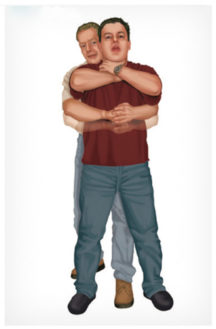Know how to help a choking victim

If a co-worker is choking, you need to act quickly. If the person is able to cough forcefully, encourage him or her to continue to clear the object. But if the person can't cough, speak or breathe, ask the person if he or she is choking. If he or she nods yes, ask for permission to help and explain that you will be administering abdominal thrusts. Then, follow these steps from the National Safety Council:
- Stand behind the choking person and place one leg between his or her legs.
- Reach around the abdomen and find the navel. Then, place the thumb-side of your fist against the abdomen, just above the navel.
- Grasp your fist with your other hand and thrust inward and upward into the person's abdomen with quick, jerking motions. (If the choking person is pregnant or if you can't get your arms around him or her, provide chest thrusts from behind and avoid squeezing the person's ribs.)
- Continue to perform thrusts until the person expels the object or becomes unresponsive.
- Seek medical attention, even after choking stops.
From the "Basic Life Support" course offered by the National Safety Council. Learn more about NSC first aid and CPR training – including online and classroom training for learners, and courses and materials for instructors. © 2015 National Safety Council
Note: If a rescuer is alone with a conscious victim who is choking, the rescuer should provide care until the object is expelled or the victim loses consciousness. If the person passes out, the rescuer should ensure 911 has been called. (If no one is around to call, the rescuer should quickly make the 911 call.)
If a choking victim becomes unresponsive, NSC says to lower the person to the ground, expose their chest and begin CPR. Check inside the person's mouth for objects, and remove anything you find. Then, you should:
- Place one hand on top of the other in the center of the chest.
- Compress the chest about 2 inches deep, 30 times, at a rate of at least 100 per minute while counting aloud.
- Tilt the head and lift the chin to open the airway.
- Give two rescue breaths, each lasting 1 second. (Look in the mouth each time you open it to give breaths, and remove any object you see.)
- Continue the cycle of two breaths and 30 compressions until the victim regains consciousness, an AED is brought to the scene or help arrives.
Post a comment to this article
Safety+Health welcomes comments that promote respectful dialogue. Please stay on topic. Comments that contain personal attacks, profanity or abusive language – or those aggressively promoting products or services – will be removed. We reserve the right to determine which comments violate our comment policy. (Anonymous comments are welcome; merely skip the “name” field in the comment box. An email address is required but will not be included with your comment.)

